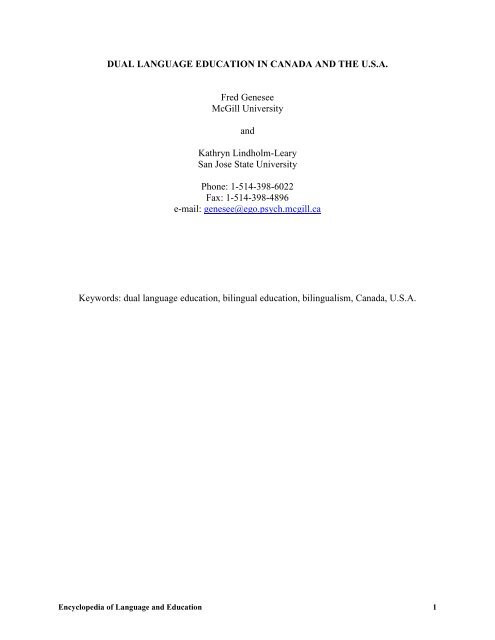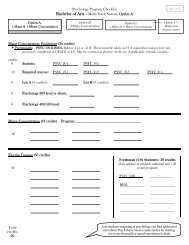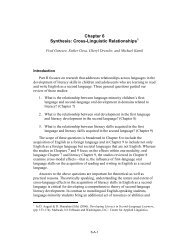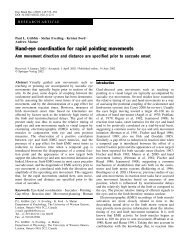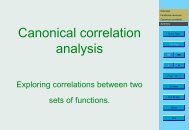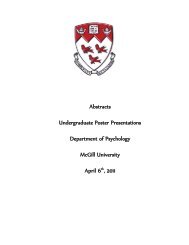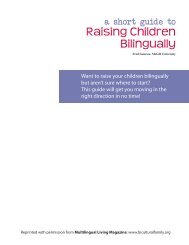Dual language education in Canada and the ... - McGill University
Dual language education in Canada and the ... - McGill University
Dual language education in Canada and the ... - McGill University
You also want an ePaper? Increase the reach of your titles
YUMPU automatically turns print PDFs into web optimized ePapers that Google loves.
DUAL LANGUAGE EDUCATION IN CANADA AND THE U.S.A.<br />
Fred Genesee<br />
<strong>McGill</strong> <strong>University</strong><br />
<strong>and</strong><br />
Kathryn L<strong>in</strong>dholm-Leary<br />
San Jose State <strong>University</strong><br />
Phone: 1-514-398-6022<br />
Fax: 1-514-398-4896<br />
e-mail: genesee@ego.psych.mcgill.ca<br />
Keywords: dual <strong>language</strong> <strong>education</strong>, bil<strong>in</strong>gual <strong>education</strong>, bil<strong>in</strong>gualism, <strong>Canada</strong>, U.S.A.<br />
Encyclopedia of Language <strong>and</strong> Education 1
DUAL LANGUAGE EDUCATION IN CANADA AND THE U.S.<br />
<strong>Dual</strong> <strong>language</strong> programs <strong>in</strong> public schools were developed <strong>in</strong> both <strong>Canada</strong> <strong>and</strong> <strong>the</strong> United<br />
States (U.S.) dur<strong>in</strong>g <strong>the</strong> 1960s, a period of considerable social change <strong>in</strong> North America, <strong>and</strong><br />
<strong>in</strong>deed worldwide. <strong>Dual</strong> <strong>language</strong> <strong>education</strong> <strong>in</strong> each country can be said to have been a<br />
reflection of more general worldwide concerns for issues of social <strong>in</strong>equality <strong>and</strong> <strong>in</strong>stitutional<br />
response, or lack of response, to <strong>in</strong>equality <strong>in</strong> a number of different spheres, <strong>in</strong>clud<strong>in</strong>g <strong>language</strong><br />
<strong>and</strong> culture. At <strong>the</strong> same time, <strong>the</strong> specific histories of each country clearly shaped <strong>the</strong> forms <strong>and</strong><br />
goals of dual <strong>language</strong> <strong>education</strong> that grew out of <strong>the</strong>se very general concerns. For purposes of<br />
this review, we def<strong>in</strong>e “dual <strong>language</strong> <strong>education</strong>” (DLE) as school<strong>in</strong>g at <strong>the</strong> elementary <strong>and</strong>/or<br />
secondary levels <strong>in</strong> which English along with ano<strong>the</strong>r <strong>language</strong> are used for at least 50% of<br />
academic <strong>in</strong>struction dur<strong>in</strong>g at least one school year. This is a m<strong>in</strong>imal def<strong>in</strong>ition that captures a<br />
wide range of alternatives. The rationale beh<strong>in</strong>d DLE is that students can learn a second <strong>language</strong><br />
effectively if it is used for significant periods of time <strong>and</strong> for substantive communication <strong>in</strong><br />
school – much like children learn <strong>the</strong>ir native <strong>language</strong> <strong>in</strong> <strong>the</strong> home (see Genesee, 1984, for a<br />
detailed description). Most DLE programs (except transitional bil<strong>in</strong>gual programs <strong>in</strong> <strong>the</strong> U.S.)<br />
also embrace an additive bil<strong>in</strong>gual conceptualization of <strong>language</strong> learn<strong>in</strong>g; namely, that addition<br />
of a second <strong>language</strong> to a child’s <strong>language</strong> repertoire is a personal, social, cognitive, <strong>and</strong><br />
economic advantage that does not need to take place at <strong>the</strong> expense of <strong>the</strong> child’s first <strong>language</strong><br />
competence. Thus, additive dual <strong>language</strong> programs aim for high levels of oral <strong>and</strong> written<br />
<strong>language</strong> proficiency <strong>in</strong> both <strong>the</strong> students’ home <strong>language</strong> <strong>and</strong> a second <strong>language</strong>.<br />
In <strong>Canada</strong>, <strong>the</strong>se programs are usually referred to as “immersion programs” <strong>and</strong> <strong>in</strong> <strong>the</strong><br />
U.S. <strong>the</strong>y go by various names (which we explicate shortly), but most generally “dual <strong>language</strong><br />
<strong>education</strong>” or “immersion <strong>education</strong>.” We use <strong>the</strong> term dual <strong>language</strong> <strong>education</strong> (DLE) to<br />
Encyclopedia of Language <strong>and</strong> Education 2
encompass both additive <strong>and</strong> non-additive program types <strong>in</strong> <strong>Canada</strong> <strong>and</strong> <strong>the</strong> U.S.A. <strong>in</strong> order to<br />
provide a comprehensive overview of DLE 1 . In this chapter, we briefly review <strong>the</strong> socio-political<br />
history of dual <strong>language</strong> <strong>education</strong> <strong>in</strong> each country. This is followed by descriptions of specific<br />
forms of DLE <strong>in</strong> each country <strong>and</strong> synopses of research undertaken to evaluate <strong>the</strong> effectiveness<br />
of <strong>the</strong>se programs. F<strong>in</strong>ally, we describe <strong>the</strong> current status of DLE <strong>in</strong> each country <strong>and</strong> identify<br />
socio-political, pedagogical, <strong>and</strong> research issues that future researchers <strong>and</strong> <strong>education</strong><br />
professionals face.<br />
Early Developments<br />
Immersion programs <strong>in</strong> English <strong>and</strong> French were created <strong>in</strong> <strong>the</strong> mid-1960s <strong>in</strong> Quebec <strong>in</strong><br />
<strong>the</strong> context of social <strong>and</strong> l<strong>in</strong>guistic <strong>in</strong>equities between <strong>the</strong> French- <strong>and</strong> English-speak<strong>in</strong>g<br />
populations of <strong>Canada</strong>. French had until <strong>the</strong> mid-60s been <strong>the</strong> disadvantaged partner <strong>in</strong> Canadian<br />
confederation despite its historical importance dur<strong>in</strong>g <strong>the</strong> early colonization <strong>and</strong> subsequent<br />
development of <strong>Canada</strong>, despite its contemporary status as an official national <strong>language</strong>, <strong>and</strong><br />
despite its demographic significance as <strong>the</strong> native <strong>language</strong> of approximately 25% of <strong>the</strong><br />
Canadian population. Evidence of <strong>the</strong> <strong>in</strong>ferior status of French has been evident <strong>in</strong> legislation,<br />
which at times prohibited <strong>the</strong> use of French; patterns of <strong>language</strong> use, which favored <strong>the</strong> use of<br />
English <strong>in</strong> most bil<strong>in</strong>gual contexts, even <strong>in</strong> Quebec; <strong>and</strong> <strong>in</strong> <strong>language</strong> attitudes (see Genesee &<br />
Holobow, 1989, for an example). Discontent over <strong>the</strong>se l<strong>in</strong>guistic <strong>and</strong> cultural <strong>in</strong>equities had<br />
been develop<strong>in</strong>g for some time among members of both <strong>the</strong> French- <strong>and</strong> English-speak<strong>in</strong>g<br />
communities, especially <strong>in</strong> Quebec. The 1960s were marked by concerted political, social, <strong>and</strong> <strong>in</strong><br />
some cases militant action <strong>in</strong> <strong>the</strong> French community of Quebec to redress <strong>the</strong> perceived<br />
imbalance <strong>in</strong> power between <strong>the</strong> English <strong>and</strong> French <strong>and</strong> to recognize <strong>the</strong> majority status of<br />
1 See <strong>the</strong> National <strong>Dual</strong> Language Consortium for a def<strong>in</strong>ition which <strong>in</strong>cludes only additive bil<strong>in</strong>gual program<br />
models; www.dual<strong>language</strong>nm.org/ndlc.html<br />
Encyclopedia of Language <strong>and</strong> Education 3
French <strong>in</strong> that prov<strong>in</strong>ce. This period <strong>in</strong> Quebec history is referred to as <strong>the</strong> “Quiet Revolution”.<br />
There was, as a result, an emerg<strong>in</strong>g awareness <strong>in</strong> <strong>the</strong> English-speak<strong>in</strong>g community that French<br />
was becom<strong>in</strong>g more important as a <strong>language</strong> of communication <strong>in</strong> most spheres of life <strong>and</strong>,<br />
concomitantly, that English alone would no longer assure social <strong>and</strong> economic success <strong>in</strong> <strong>the</strong><br />
prov<strong>in</strong>ce. In response to <strong>the</strong>ir dissatisfaction with this state of affairs, a concerned group of<br />
English-speak<strong>in</strong>g parents <strong>in</strong> <strong>the</strong> suburban community of St. Lambert, outside of Montreal, began<br />
to meet <strong>in</strong>formally <strong>in</strong> <strong>the</strong> early 1960s to discuss strategies for change (Lambert & Tucker, 1972).<br />
These parents attributed <strong>the</strong> two solitudes that characterized <strong>the</strong>ir relationship with francophone<br />
Quebecers to <strong>the</strong>ir <strong>and</strong> <strong>the</strong>ir children’s l<strong>in</strong>guistic <strong>in</strong>competence <strong>in</strong> French. They were determ<strong>in</strong>ed<br />
to improve <strong>the</strong> quality of second <strong>language</strong> <strong>in</strong>struction <strong>in</strong> English schools <strong>and</strong> “immersion” was<br />
<strong>the</strong> <strong>education</strong>al improvement <strong>the</strong>y developed. The first immersion class was opened <strong>in</strong><br />
September 1965. The primary goals of immersion programs were to provide <strong>the</strong> participat<strong>in</strong>g<br />
students with functional competence <strong>in</strong> both written <strong>and</strong> spoken aspects of French, normal levels<br />
of English-<strong>language</strong> development, <strong>and</strong> achievement <strong>in</strong> academic subjects commensurate with <strong>the</strong><br />
students' ability <strong>and</strong> grade level. They also aimed to ensure an underst<strong>and</strong><strong>in</strong>g <strong>and</strong> appreciation of<br />
French Canadian people, <strong>the</strong>ir <strong>language</strong>, <strong>and</strong> culture, without detract<strong>in</strong>g <strong>in</strong> any way from <strong>the</strong><br />
students' identity with <strong>and</strong> appreciation for English Canadian culture. It was also hoped that<br />
immersion programs would result <strong>in</strong> improved relationships between English-speak<strong>in</strong>g <strong>and</strong><br />
French-speak<strong>in</strong>g Quebecers <strong>and</strong>, more generally, Canadians who spoke English <strong>and</strong> French.<br />
Many parents across <strong>the</strong> country came to embrace <strong>the</strong>se goals. Immersion programs <strong>in</strong> o<strong>the</strong>r<br />
<strong>language</strong>s besides French are also available <strong>in</strong> <strong>Canada</strong>; for example, Ukra<strong>in</strong>ian, German, Polish,<br />
Cree, Hewbrew, <strong>and</strong> M<strong>and</strong>ar<strong>in</strong>. Some of <strong>the</strong>se programs <strong>in</strong>clude students from m<strong>in</strong>ority ethnic<br />
group backgrounds who have learned English as a first <strong>language</strong> <strong>and</strong>, thus, are learn<strong>in</strong>g a<br />
Encyclopedia of Language <strong>and</strong> Education 4
heritage <strong>language</strong>. Some of <strong>the</strong>se programs also <strong>in</strong>clude students who are native speakers of <strong>the</strong><br />
non-English <strong>language</strong> <strong>and</strong>, thus, wish to ma<strong>in</strong>ta<strong>in</strong> that <strong>language</strong> <strong>and</strong> acquire <strong>the</strong> majority societal<br />
<strong>language</strong>, English. Some programs also <strong>in</strong>clude majority group Canadian students who are<br />
native-speakers of English <strong>and</strong> wish to learn <strong>the</strong> non-English <strong>language</strong> as a form of l<strong>in</strong>guistic<br />
enrichment. All of <strong>the</strong>se programs aim for additive bil<strong>in</strong>gualism.<br />
The socio-political history of DLE <strong>in</strong> <strong>the</strong> U.S. has been complex, with bil<strong>in</strong>gual <strong>education</strong><br />
tolerated <strong>in</strong> German, French, <strong>and</strong> Sc<strong>and</strong><strong>in</strong>avian <strong>language</strong>s <strong>in</strong> <strong>the</strong> 18 th <strong>and</strong> 19 th centuries <strong>in</strong> some<br />
states while <strong>in</strong>struction through any non-English <strong>language</strong> was outlawed <strong>in</strong> o<strong>the</strong>r states. In <strong>the</strong><br />
20 th century, <strong>the</strong> late 50s <strong>and</strong> early 60s brought about important changes to <strong>language</strong> <strong>education</strong>.<br />
With <strong>the</strong> launch<strong>in</strong>g of Sputnik by <strong>the</strong> Soviet Union, <strong>the</strong> U.S. embarked on an effort to improve<br />
<strong>education</strong> <strong>in</strong> general <strong>and</strong> to <strong>in</strong>clude foreign <strong>language</strong> competence <strong>in</strong> particular as an important<br />
<strong>education</strong>al goal. At <strong>the</strong> same time, <strong>the</strong> Cuban revolution sent waves of Cuban refugees to <strong>the</strong><br />
U.S., result<strong>in</strong>g <strong>in</strong> <strong>the</strong> first official bil<strong>in</strong>gual program <strong>in</strong> <strong>the</strong> U.S. -- at Coral Way School <strong>in</strong> Miami,<br />
Florida. This program was created to allow Spanish-speak<strong>in</strong>g children of Cuban refugees to<br />
reta<strong>in</strong> competence <strong>in</strong> <strong>the</strong>ir native <strong>language</strong> <strong>and</strong> to acquire competence <strong>in</strong> English. Subsequent<br />
political events pushed bil<strong>in</strong>gual <strong>education</strong> onto <strong>the</strong> agenda of <strong>the</strong> national <strong>education</strong> community.<br />
Instigated by a federal lawsuit (Brown v. Board of Education <strong>in</strong> 1954) on <strong>the</strong> constitutionality of<br />
segregated <strong>education</strong>, <strong>the</strong> Civil Rights Act of 1964 declared that no person could be excluded<br />
from or discrim<strong>in</strong>ated aga<strong>in</strong>st <strong>in</strong> any program funded by <strong>the</strong> U.S. federal government on <strong>the</strong> basis<br />
of race or national orig<strong>in</strong>, <strong>the</strong>reby rais<strong>in</strong>g concerns about <strong>the</strong> sole use of English to educate<br />
m<strong>in</strong>ority <strong>language</strong> students <strong>in</strong> public schools. Subsequently, <strong>the</strong> Elementary <strong>and</strong> Secondary<br />
Education Act of 1969 provided assistance to local <strong>education</strong>al authorities to establish bil<strong>in</strong>gual<br />
programs for Spanish-speak<strong>in</strong>g children across <strong>the</strong> nation.<br />
Encyclopedia of Language <strong>and</strong> Education 5
The scope of bil<strong>in</strong>gual <strong>education</strong> was exp<strong>and</strong>ed considerably <strong>in</strong> 1970, when <strong>the</strong> Office of<br />
Civil Rights issued an official memor<strong>and</strong>um that directed school districts to take affirmative<br />
action to ensure that students of “national-orig<strong>in</strong>” (<strong>in</strong>clud<strong>in</strong>g children who did not speak English)<br />
were provided equal <strong>education</strong>al opportunity, as outl<strong>in</strong>ed by Civil Rights Act of 1964. Education<br />
through m<strong>in</strong>ority <strong>language</strong> students’ native <strong>language</strong> along with English became <strong>the</strong> preferred<br />
mode of compliance with <strong>the</strong> OCR memor<strong>and</strong>um follow<strong>in</strong>g <strong>the</strong> Supreme Court decision <strong>in</strong> Lau<br />
vs. Nichols <strong>in</strong> 1974, a class action suit filed on behalf of <strong>the</strong> Ch<strong>in</strong>ese community <strong>in</strong> San<br />
Francisco who contended that <strong>the</strong>ir children were denied “equal <strong>education</strong> opportunity” <strong>in</strong><br />
English-only schools s<strong>in</strong>ce <strong>the</strong>y were compelled to attend schools <strong>in</strong> which <strong>in</strong>struction was<br />
provided <strong>in</strong> a <strong>language</strong> <strong>the</strong>y did not underst<strong>and</strong>. The same year, <strong>the</strong> reauthorization of <strong>the</strong><br />
Elementary <strong>and</strong> Education Act for <strong>the</strong> first time provided a def<strong>in</strong>ition of bil<strong>in</strong>gual <strong>education</strong> – “It<br />
is <strong>in</strong>struction given <strong>in</strong>, <strong>and</strong> study of, English <strong>and</strong> (to <strong>the</strong> extent necessary to allow a child to<br />
progress effectively through <strong>the</strong> <strong>education</strong> system) <strong>the</strong> native <strong>language</strong> of <strong>the</strong> children of limited<br />
English-speak<strong>in</strong>g ability…” Thus, federally funded <strong>education</strong> programs were to <strong>in</strong>clude native<br />
<strong>language</strong> <strong>in</strong>struction (<strong>and</strong> cultural enrichment); ESL <strong>in</strong>struction alone was not perceived as<br />
sufficient to provide equal <strong>education</strong>al opportunity to students who came to school with no or<br />
limited proficiency <strong>in</strong> English.<br />
DLE became an option for majority English-speak<strong>in</strong>g students <strong>in</strong> <strong>the</strong> U.S. when, <strong>in</strong> 1971,<br />
a Canadian-style Spanish-English immersion program was <strong>in</strong>stituted <strong>in</strong> Culver City, California<br />
(see Cohen, 1974). In <strong>the</strong> 1970s <strong>and</strong> 1980s, Canadian-style immersion <strong>and</strong> bil<strong>in</strong>gual <strong>education</strong><br />
were extended to <strong>in</strong>clude both m<strong>in</strong>ority <strong>and</strong> majority <strong>language</strong> students <strong>in</strong> <strong>the</strong> same classrooms<br />
(see L<strong>in</strong>dholm-Leary, 2001); <strong>the</strong>se are often referred to as two-way immersion, two-way<br />
bil<strong>in</strong>gual, or dual <strong>language</strong> programs. This has become <strong>the</strong> most prevalent form of DLE for<br />
Encyclopedia of Language <strong>and</strong> Education 6
majority <strong>language</strong> students <strong>in</strong> <strong>the</strong> U.S. with over 338 programs <strong>in</strong> 2006 (Center for Applied<br />
L<strong>in</strong>guistics, 2006).<br />
Program Models<br />
There are a variety of forms of immersion <strong>in</strong> <strong>Canada</strong> (Genesee, 2004). They differ with<br />
respect to <strong>the</strong> grade/age level when <strong>the</strong> second <strong>language</strong> is used for <strong>in</strong>tensive academic<br />
<strong>in</strong>struction, <strong>the</strong> number of years when academic subjects are taught <strong>in</strong> <strong>the</strong> second <strong>language</strong>, <strong>and</strong><br />
<strong>the</strong> amount of <strong>in</strong>structional time dur<strong>in</strong>g <strong>the</strong> school year provided through <strong>the</strong> second <strong>and</strong> native<br />
<strong>language</strong>s. One can dist<strong>in</strong>guish early immersion (beg<strong>in</strong>n<strong>in</strong>g <strong>in</strong> k<strong>in</strong>dergarten or grade 1) from<br />
middle immersion (beg<strong>in</strong>n<strong>in</strong>g <strong>in</strong> grade 4 or 5) <strong>and</strong> late immersion (beg<strong>in</strong>n<strong>in</strong>g <strong>in</strong> grade 7, or <strong>the</strong><br />
<strong>in</strong>itial grades of secondary school). Programs that provide a delayed or late start provide core<br />
second <strong>language</strong> <strong>in</strong>struction to students <strong>in</strong> <strong>the</strong> grades that precede <strong>the</strong> beg<strong>in</strong>n<strong>in</strong>g of immersion;<br />
e.g., from k<strong>in</strong>dergarten to grade 6 <strong>in</strong> <strong>the</strong> case of a grade 7 late immersion program. Programs also<br />
differ with respect to <strong>the</strong> extent of <strong>in</strong>struction through <strong>the</strong> second <strong>language</strong> – <strong>in</strong> early partial<br />
immersion programs, 50% of <strong>in</strong>struction <strong>in</strong> a given year is presented <strong>in</strong> <strong>the</strong> second <strong>language</strong> <strong>and</strong><br />
50% <strong>in</strong> <strong>the</strong> native <strong>language</strong> of <strong>the</strong> students. In total immersion programs, all <strong>in</strong>struction for one<br />
or more years is presented through <strong>the</strong> medium of <strong>the</strong> second <strong>language</strong>. Notwithst<strong>and</strong><strong>in</strong>g such<br />
programmatic variation, all Canadian immersion programs aim for (a) advanced levels of<br />
functional proficiency <strong>in</strong> written <strong>and</strong> oral forms of <strong>the</strong> second <strong>language</strong>, (b) normal levels of first<br />
<strong>language</strong> competence, <strong>and</strong> (c) grade-appropriate levels of achievement <strong>in</strong> academic school<br />
subjects. An additional, <strong>and</strong> sometimes only implicit, goal is to promote awareness,<br />
underst<strong>and</strong><strong>in</strong>g, <strong>and</strong> tolerance of <strong>the</strong> culture of <strong>the</strong> second <strong>language</strong> group.<br />
There are more varied models of DLE <strong>in</strong> <strong>the</strong> U.S. (see Genesee, 1999; L<strong>in</strong>dholm-Leary,<br />
2001; L<strong>in</strong>dholm-Leary & Borsato, 2006, for more details). Canadian-style immersion programs,<br />
Encyclopedia of Language <strong>and</strong> Education 7
as well as two-way immersion programs (to be described shortly), are available to majority<br />
<strong>language</strong> students <strong>in</strong> a number of different <strong>language</strong>s, with Spanish be<strong>in</strong>g <strong>the</strong> most common.<br />
U.S. immersion programs for native English speakers, which are <strong>in</strong>cluded <strong>in</strong> 7% of public<br />
elementary schools, take <strong>the</strong> form of early immersion <strong>and</strong> share essentially <strong>the</strong> same goals as<br />
<strong>the</strong>ir Canadian counterparts (Rhodes & Branaman, 1999).<br />
There are three basic models of DLE for m<strong>in</strong>ority <strong>language</strong> students <strong>in</strong> <strong>the</strong> U.S. In<br />
transitional bil<strong>in</strong>gual <strong>education</strong> (TBE), <strong>the</strong> students’ home <strong>language</strong> is used only dur<strong>in</strong>g <strong>the</strong><br />
first two or three grades of primary school<strong>in</strong>g to teach academic <strong>and</strong> <strong>in</strong>itial literacy skills while<br />
students acquire English as a second <strong>language</strong>. Students transition to all-English <strong>in</strong>struction<br />
usually <strong>in</strong> grade 3, or at such time as <strong>the</strong>y are deemed to be capable of benefit<strong>in</strong>g from Englishonly<br />
<strong>in</strong>struction. In contrast, developmental bil<strong>in</strong>gual programs <strong>and</strong> two-way immersion<br />
programs aim for full competence <strong>in</strong> oral <strong>and</strong> written forms of <strong>the</strong> students’ home <strong>language</strong> <strong>and</strong><br />
English, <strong>the</strong>ir second <strong>language</strong>. These goals are accomplished by teach<strong>in</strong>g academic <strong>and</strong> literacy<br />
skills <strong>in</strong> both <strong>language</strong>s, although <strong>the</strong> same subjects are not taught simultaneously <strong>in</strong> both<br />
<strong>language</strong>s. The portion of <strong>the</strong> school day that is taught through each <strong>language</strong> differs – <strong>the</strong> most<br />
common patterns be<strong>in</strong>g 90% native <strong>language</strong> <strong>and</strong> 10% English or 50% native <strong>language</strong> <strong>and</strong> 50%<br />
English – so-called 90/10 <strong>and</strong> 50/50 models, respectively. In 90/10 programs, students learn to<br />
read first <strong>in</strong> <strong>the</strong> target <strong>language</strong> (e.g., Spanish), <strong>and</strong> <strong>the</strong>n add read<strong>in</strong>g <strong>in</strong>struction through English<br />
<strong>in</strong> third grade. In 50/50 programs, students learn to read first <strong>in</strong> <strong>the</strong>ir primary <strong>language</strong> <strong>and</strong> <strong>the</strong>n<br />
add <strong>the</strong> second <strong>language</strong> <strong>in</strong> grade 2 or 3, or <strong>the</strong>y learn to read simultaneously through both<br />
<strong>language</strong>s.<br />
Developmental programs differ from two-way programs <strong>in</strong> that all students <strong>in</strong> <strong>the</strong> former<br />
come from <strong>language</strong> m<strong>in</strong>ority backgrounds, usually Hispanic, whereas a third to a half of <strong>the</strong><br />
Encyclopedia of Language <strong>and</strong> Education 8
students <strong>in</strong> two-way programs are members of <strong>the</strong> majority English <strong>language</strong> group. Both are<br />
additive forms of DLE, as are <strong>the</strong> Canadian immersion programs, s<strong>in</strong>ce <strong>the</strong>y aim to ma<strong>in</strong>ta<strong>in</strong> <strong>the</strong><br />
students’ native <strong>language</strong> at <strong>the</strong> same time as <strong>the</strong>y promote competence <strong>in</strong> <strong>the</strong> o<strong>the</strong>r <strong>language</strong><br />
along with high st<strong>and</strong>ards <strong>in</strong> academic subjects. There is one critical difference between DLE<br />
for m<strong>in</strong>ority students <strong>in</strong> <strong>the</strong> U.S. <strong>and</strong> DLE <strong>education</strong> for majority <strong>language</strong> students <strong>in</strong> <strong>the</strong> U.S.<br />
<strong>and</strong> <strong>Canada</strong>, namely, m<strong>in</strong>ority <strong>language</strong> students <strong>in</strong> DLE programs are expected to acquire levels<br />
of proficiency <strong>in</strong> both oral <strong>and</strong> written English that are at grade level or <strong>in</strong> accordance with<br />
district <strong>and</strong> state expectations for typically develop<strong>in</strong>g native English speakers. This obviously<br />
arises from <strong>the</strong> fact that <strong>the</strong> second <strong>language</strong> for m<strong>in</strong>ority students <strong>in</strong> <strong>the</strong> U.S. is English, <strong>the</strong><br />
dom<strong>in</strong>ant societal <strong>language</strong>, whereas <strong>in</strong> DLE programs for majority <strong>language</strong> students <strong>in</strong> both<br />
countries, <strong>the</strong> students’ second <strong>language</strong> is considered a m<strong>in</strong>ority <strong>language</strong> relative to <strong>the</strong><br />
importance of English; this is true even <strong>in</strong> Quebec, where French is <strong>the</strong> dom<strong>in</strong>ant <strong>language</strong>. In<br />
contrast, DLE programs for majority English-speak<strong>in</strong>g students <strong>in</strong> <strong>Canada</strong> <strong>and</strong> <strong>the</strong> U.S. are<br />
deemed to be successful if students achieve advanced levels of functional proficiency <strong>in</strong> <strong>the</strong>ir<br />
second <strong>language</strong> even if <strong>the</strong>ir proficiency is not on par with native speakers of <strong>the</strong> target<br />
<strong>language</strong>.<br />
Major Contributions<br />
There has been extensive research on <strong>the</strong> <strong>language</strong> <strong>and</strong> academic development of<br />
English-speak<strong>in</strong>g students <strong>in</strong> Canadian DLE programs, <strong>and</strong> most notably French immersion<br />
(Genesee, 2004). The f<strong>in</strong>d<strong>in</strong>gs from <strong>the</strong>se evaluations have been replicated, for <strong>the</strong> most part, <strong>in</strong><br />
evaluations of DLE programs with different second <strong>language</strong>s <strong>and</strong> <strong>in</strong> o<strong>the</strong>r regions of <strong>the</strong> world,<br />
<strong>in</strong>clud<strong>in</strong>g <strong>the</strong> U.S., where similar programs with majority <strong>language</strong> students have been<br />
implemented (Christian & Genesee, 2001; Johnson & Swa<strong>in</strong>, 1997). In brief, research has<br />
Encyclopedia of Language <strong>and</strong> Education 9
consistently shown that English-speak<strong>in</strong>g Canadian students <strong>in</strong> all forms of French immersion<br />
acquire significantly more advanced levels of functional proficiency <strong>in</strong> French than students who<br />
receive conventional second <strong>language</strong> <strong>in</strong>struction – that is, <strong>in</strong>struction that focuses primarily on<br />
<strong>language</strong> learn<strong>in</strong>g <strong>and</strong> is restricted to separate, limited periods of time. Proficiency has been<br />
assessed with respect to speak<strong>in</strong>g, listen<strong>in</strong>g, read<strong>in</strong>g, <strong>and</strong> writ<strong>in</strong>g. Many researchers have<br />
reported that immersion students’ comprehension skills (read<strong>in</strong>g <strong>and</strong> listen<strong>in</strong>g) <strong>in</strong> French are less<br />
advanced than <strong>the</strong>ir production skills (speak<strong>in</strong>g <strong>and</strong> writ<strong>in</strong>g) <strong>and</strong> that immersion students seldom<br />
atta<strong>in</strong> native-like grammatical accuracy or idiomatic usage <strong>and</strong> <strong>the</strong>y often have a limited range of<br />
vocabulary <strong>and</strong> pragmatic competence <strong>in</strong> French even after 10 to 12 years participation <strong>in</strong><br />
immersion (see Genesee, 2004, for more details).<br />
At <strong>the</strong> same time, French immersion students develop <strong>the</strong> same levels of proficiency <strong>in</strong><br />
all aspects of English as comparable students <strong>in</strong> English-only programs. There can be a lag <strong>in</strong> <strong>the</strong><br />
development of English literacy skills (read<strong>in</strong>g, writ<strong>in</strong>g, <strong>and</strong> spell<strong>in</strong>g) among students <strong>in</strong> <strong>the</strong><br />
<strong>in</strong>itial years of early total immersion when all academic <strong>in</strong>struction is <strong>in</strong> French. Parity with<br />
control students who have been <strong>in</strong>structed entirely <strong>in</strong> English is usually achieved by early total<br />
immersion students after one year of English <strong>in</strong>struction. The English <strong>language</strong> development of<br />
students who beg<strong>in</strong> immersion beyond <strong>the</strong> primary grades -- <strong>in</strong> <strong>the</strong> middle elementary or <strong>in</strong>itial<br />
secondary school grades, usually shows that <strong>the</strong>se students exhibit age-appropriate English skills<br />
at all grade levels. Research has also shown that immersion students generally achieve <strong>the</strong> same<br />
levels of achievement <strong>in</strong> academic doma<strong>in</strong>s (e.g., science <strong>and</strong> ma<strong>the</strong>matics) as comparable<br />
students <strong>in</strong> English-only programs. Parity with control students is often exhibited even when<br />
immersion students receive all academic <strong>in</strong>struction through French, provided <strong>the</strong> assessment is<br />
Encyclopedia of Language <strong>and</strong> Education 10
conducted <strong>in</strong> French <strong>and</strong> modifications are made to take <strong>in</strong>to account that full competence <strong>in</strong> <strong>the</strong><br />
second <strong>language</strong> has not been acquired.<br />
Research has also shown that English-speak<strong>in</strong>g immersion students who are at-risk for<br />
academic <strong>and</strong> <strong>language</strong> learn<strong>in</strong>g difficulties due to socio-economic, cognitive, or first <strong>language</strong><br />
disadvantages generally achieve <strong>the</strong> same levels of competence <strong>in</strong> English <strong>and</strong> academic<br />
doma<strong>in</strong>s as comparable at-risk students <strong>in</strong> English-only programs. At-risk students <strong>in</strong> immersion<br />
generally perform less well than students <strong>in</strong> <strong>the</strong> same program who are not at-risk, but <strong>the</strong>ir<br />
progress is not differentially impeded <strong>in</strong> comparison to comparable students <strong>in</strong> English<br />
programs. At <strong>the</strong> same time, at-risk students benefit from DLE by acquir<strong>in</strong>g advanced levels of<br />
functional proficiency <strong>in</strong> <strong>the</strong> second <strong>language</strong>. O<strong>the</strong>r research that has exam<strong>in</strong>ed differences <strong>in</strong><br />
second <strong>language</strong> achievement as a function of start<strong>in</strong>g grade level (i.e., early versus late<br />
immersion) <strong>and</strong> amount of exposure to <strong>the</strong> second <strong>language</strong> (total versus partial) has revealed<br />
that early immersion students often achieve higher levels of proficiency <strong>in</strong> French than late<br />
immersion students, but not always, <strong>and</strong> that total immersion generally yields higher levels of<br />
second <strong>language</strong> proficiency than partial immersion (Genesee, 2004).<br />
Evaluations of DLE for majority <strong>language</strong> students <strong>in</strong> <strong>the</strong> U.S. have yielded results that are<br />
comparable to those found <strong>in</strong> <strong>Canada</strong> with respect to general program goals; that is, with respect<br />
to first <strong>language</strong> development, academic achievement, <strong>and</strong> second <strong>language</strong> proficiency<br />
(Howard, Sugarman & Christian, 2003; L<strong>in</strong>dholm-Leary, 2001). Majority <strong>language</strong> students <strong>in</strong><br />
immersion <strong>and</strong> two-way programs often score below comparison students <strong>in</strong> English <strong>language</strong><br />
<strong>and</strong> literacy <strong>in</strong> <strong>the</strong> <strong>in</strong>itial two or three grades of elementary school, but are at par with or exceed<br />
<strong>the</strong> performance of comparable students <strong>in</strong> all-English programs by <strong>the</strong> end of elementary<br />
school. As found <strong>in</strong> immersion <strong>education</strong> <strong>in</strong> <strong>Canada</strong>, students <strong>in</strong> two-way programs from a<br />
Encyclopedia of Language <strong>and</strong> Education 11
variety of ethnic <strong>and</strong> socio-economic backgrounds, <strong>and</strong> even special needs students, achieve at<br />
levels commensurate with or higher than <strong>the</strong>ir monol<strong>in</strong>gual peers <strong>in</strong> English-only classes.<br />
Evaluations of DLE for m<strong>in</strong>ority <strong>language</strong> students <strong>in</strong> <strong>the</strong> U.S. have revealed that students <strong>in</strong><br />
two-way immersion <strong>and</strong> developmental bil<strong>in</strong>gual programs achieve outcomes <strong>in</strong> English oral<br />
<strong>language</strong> <strong>and</strong> literacy <strong>and</strong> academic doma<strong>in</strong>s that are comparable to, or higher <strong>in</strong> some cases<br />
than, comparison students (i.e., Hispanic students) <strong>in</strong> all-English programs, while also<br />
demonstrat<strong>in</strong>g higher levels of Spanish <strong>language</strong> competence (L<strong>in</strong>dholm-Leary & Borsato, 2006;<br />
Thomas & Collier, 2002). Parity <strong>in</strong> English with comparison students <strong>in</strong> all-English programs is<br />
not always evident dur<strong>in</strong>g <strong>the</strong> <strong>in</strong>itial grades of DLE, but is evident by <strong>the</strong> end of elementary<br />
school. Comparisons between <strong>the</strong> st<strong>and</strong>ardized test results of m<strong>in</strong>ority <strong>language</strong> students <strong>in</strong> DLE<br />
programs <strong>and</strong> district/state or national test norms have found that students <strong>in</strong> developmental<br />
bil<strong>in</strong>gual <strong>and</strong> two-way immersion programs usually score at norm, or higher. M<strong>in</strong>ority <strong>language</strong><br />
students <strong>in</strong> TBE programs generally score better on <strong>language</strong>, literacy, <strong>and</strong> academic<br />
achievement tests than similar students <strong>in</strong> all-English programs that provide no special<br />
accommodations, but not as high as m<strong>in</strong>ority <strong>language</strong> students <strong>in</strong> two-way <strong>and</strong> developmental<br />
programs. Long-term studies of <strong>the</strong> outcomes of m<strong>in</strong>ority <strong>language</strong> students <strong>in</strong> such programs<br />
<strong>in</strong>dicate that <strong>the</strong>re is a positive correlation between length of participation <strong>in</strong> <strong>the</strong> program <strong>and</strong><br />
academic (<strong>in</strong>clud<strong>in</strong>g) literacy outcomes <strong>and</strong> between level of bil<strong>in</strong>gual competence <strong>and</strong><br />
achievement <strong>in</strong> academic subjects such as ma<strong>the</strong>matics. L<strong>in</strong>dholm-Leary <strong>and</strong> Borsato (2006)<br />
present a more detailed summary of studies on DLE for m<strong>in</strong>ority <strong>language</strong> students, <strong>in</strong>clud<strong>in</strong>g<br />
results perta<strong>in</strong><strong>in</strong>g to o<strong>the</strong>r programmatic <strong>and</strong> <strong>in</strong>structional issues.<br />
There are significant po<strong>in</strong>ts of convergence <strong>in</strong> <strong>the</strong> f<strong>in</strong>d<strong>in</strong>gs of evaluations of additive DLE for<br />
majority <strong>and</strong> m<strong>in</strong>ority <strong>language</strong> students, despite <strong>the</strong> differential status that <strong>the</strong>ir first <strong>language</strong>s<br />
Encyclopedia of Language <strong>and</strong> Education 12
<strong>and</strong> cultures enjoy: (1) achievement levels of students <strong>in</strong> additive DLE, <strong>in</strong>clud<strong>in</strong>g levels of<br />
proficiency <strong>in</strong> <strong>the</strong> target <strong>language</strong>s, are most evident <strong>the</strong> longer students are <strong>in</strong> <strong>the</strong> program <strong>and</strong>,<br />
usually, after 5 or 6 years; (2) <strong>in</strong> a related ve<strong>in</strong>, parity with native speakers of <strong>the</strong> majority<br />
<strong>language</strong> is often not evidenced <strong>in</strong> <strong>the</strong> primary grades but is apparent by <strong>the</strong> end of elementary<br />
school; (3) <strong>the</strong>re is no consistent relationship between amount of exposure to <strong>the</strong> majority<br />
<strong>language</strong> <strong>and</strong> proficiency <strong>in</strong> that <strong>language</strong>, at least by <strong>the</strong> end of elementary school; (b) <strong>in</strong><br />
contrast, more exposure to <strong>the</strong> m<strong>in</strong>ority <strong>language</strong> (Spanish <strong>in</strong> <strong>the</strong> U.S. <strong>and</strong> French <strong>in</strong> <strong>Canada</strong>) is<br />
usually associated with higher levels of proficiency <strong>in</strong> that <strong>language</strong>; (5) <strong>in</strong>struction through a<br />
second <strong>language</strong> does not impair students’ achievement <strong>in</strong> academic subject matter; <strong>and</strong> (6)<br />
higher levels of bil<strong>in</strong>gual proficiency are associated with higher levels of academic <strong>and</strong> cognitive<br />
development (see Genesee, L<strong>in</strong>dholm-Leary, Saunders & Christian, 2006).<br />
Future Directions<br />
DLE emerged <strong>in</strong> <strong>the</strong> 1960s <strong>in</strong> <strong>Canada</strong> <strong>and</strong> <strong>the</strong> U.S.A. as responses to national issues of equity<br />
<strong>and</strong> diversity. S<strong>in</strong>ce that time, globalization has become evident <strong>in</strong> economic, communication,<br />
<strong>and</strong> o<strong>the</strong>r spheres of people’s lives <strong>and</strong> <strong>the</strong> dual <strong>language</strong> competence as well as familiarity with<br />
o<strong>the</strong>r cultures that DLE affords are <strong>in</strong>creas<strong>in</strong>gly be<strong>in</strong>g viewed as assets <strong>in</strong> this global context.<br />
Immersion programs cont<strong>in</strong>ue to thrive <strong>in</strong> <strong>Canada</strong>, primarily <strong>in</strong> French, but also <strong>in</strong> o<strong>the</strong>r<br />
<strong>language</strong>s (Genesee, 2004). Similarly, DLE programs for majority <strong>language</strong> students <strong>in</strong> <strong>the</strong> U.S.<br />
cont<strong>in</strong>ue to grow, particularly <strong>in</strong> <strong>the</strong> form of two-way immersion programs. At <strong>the</strong> same time,<br />
<strong>the</strong>re have been constra<strong>in</strong>ts imposed on <strong>the</strong> growth of DLE programs for m<strong>in</strong>ority <strong>language</strong><br />
students <strong>in</strong> <strong>the</strong> U.S. as a result of legislative changes concern<strong>in</strong>g English-only <strong>in</strong>struction<br />
imposed <strong>in</strong> some states. It rema<strong>in</strong>s to be seen how profound <strong>and</strong> for how long <strong>the</strong>se restrictions<br />
will be, especially <strong>in</strong> light of <strong>the</strong> <strong>in</strong>creased pressure on U.S. educators <strong>and</strong> parents to take<br />
Encyclopedia of Language <strong>and</strong> Education 13
account of globalization. While <strong>the</strong>re is considerable <strong>and</strong> reassur<strong>in</strong>g research on alternative<br />
forms of DLE <strong>in</strong> both <strong>Canada</strong> <strong>and</strong> <strong>the</strong> U.S., <strong>the</strong>re are a number of outst<strong>and</strong><strong>in</strong>g questions of a<br />
pedagogical nature that need research attention if program models are to evolve <strong>and</strong> become<br />
more effective. Among <strong>the</strong>se issues are <strong>the</strong> follow<strong>in</strong>g:<br />
1. What pedagogical approaches are most effective <strong>in</strong> promot<strong>in</strong>g <strong>language</strong> acquisition s<strong>in</strong>ce, as<br />
noted earlier, DLE students often exhibit <strong>in</strong>adequacies <strong>in</strong> <strong>the</strong>ir <strong>language</strong> skills even after<br />
extended participation <strong>in</strong> DLE programs? In particular, are <strong>the</strong>re specific <strong>in</strong>structional strategies<br />
that enhance students’ mastery of grammatical features of <strong>the</strong> L2 while ma<strong>in</strong>ta<strong>in</strong><strong>in</strong>g students’<br />
communicative fluency? What forms of corrective feedback produce significant, long-term<br />
ga<strong>in</strong>s <strong>in</strong> l<strong>in</strong>guistic competence?<br />
2. Are <strong>the</strong>re students for whom DLE is not effective? In particular, are bil<strong>in</strong>gual programs suitable<br />
for students with severe cognitive, perceptuo-motor, or affective disorders? In a related ve<strong>in</strong>, do<br />
at-risk students <strong>in</strong> DLE programs exhibit <strong>the</strong> same challenges <strong>and</strong> to <strong>the</strong> same extent as<br />
comparable students <strong>in</strong> monol<strong>in</strong>gual programs <strong>and</strong> what <strong>in</strong>tervention strategies are effective for<br />
students with such learn<strong>in</strong>g challenges? Should services for students with special needs be<br />
provided <strong>in</strong> <strong>the</strong> native or <strong>the</strong> second <strong>language</strong>?<br />
3. Are <strong>the</strong>re specific <strong>in</strong>structional strategies that are particularly effective for teach<strong>in</strong>g<br />
typologically dist<strong>in</strong>ct <strong>language</strong>s? To date, most programs <strong>and</strong> research have exam<strong>in</strong>ed<br />
l<strong>in</strong>guistically similar <strong>language</strong>s (i.e., English <strong>and</strong> French or Spanish). Similarly, how can<br />
literacy best be taught <strong>in</strong> <strong>language</strong>s with orthographically dist<strong>in</strong>ct writ<strong>in</strong>g systems? Is<br />
simultaneous or successive <strong>in</strong>troduction of literacy <strong>in</strong>struction <strong>in</strong> two <strong>language</strong>s with different<br />
typologies <strong>and</strong>/or orthographies preferable?<br />
4. What k<strong>in</strong>ds of skills <strong>and</strong> professional development are required of teachers so that <strong>the</strong>y can<br />
Encyclopedia of Language <strong>and</strong> Education 14
work effectively <strong>in</strong> DLE programs.<br />
The reader is referred to <strong>the</strong> follow<strong>in</strong>g for extended reviews of research on DLE <strong>in</strong><br />
<strong>Canada</strong> <strong>and</strong> <strong>the</strong> U.S.: Genesee (2004), Genesee & G<strong>and</strong>ara (1999), Howard, Sugarman &<br />
Christian (2003), <strong>and</strong> L<strong>in</strong>dholm-Leary (2001, L<strong>in</strong>dholm-Leary & Borsato, 2006).<br />
References<br />
Brecht, R. D. <strong>and</strong> Ingold, C. W.: 2002, Tapp<strong>in</strong>g a National Resource: Heritage Languages <strong>in</strong><br />
<strong>the</strong> United States. National Foreign Language Center, Ames, Iowa.<br />
Center for Applied L<strong>in</strong>guistics: 2006, Directory of Two-Way Bil<strong>in</strong>gual Immersion Programs<br />
<strong>in</strong> <strong>the</strong> U.S. Retrieved December 20, 2006, from http://www.cal.org/twi/directory.<br />
Christian, D. <strong>and</strong> Genesee, F. (Eds.) 2001, Bil<strong>in</strong>gual Education, TESOL, Alex<strong>and</strong>ria, VA.<br />
Cohen, A. D.: 1974,. The Culver City Spanish immersion program: The first two years,<br />
Modern Language Journal 58, 95–103.<br />
Genesee, F.: 1984, Historical <strong>and</strong> <strong>the</strong>oretical foundations of immersion <strong>education</strong>, <strong>in</strong> Studies<br />
on immersion <strong>education</strong>: A collection for U.S. educators, California State Department of<br />
Education, Sacramento, CA.<br />
Genesee, F.: 1999, Program Alternatives for L<strong>in</strong>guistically Diverse Students. Educational<br />
Practice Report #1, Center for Research on Education, Diversity <strong>and</strong> Excellence, Santa Cruz,<br />
CA.<br />
Genesee, F.: 2004, What do we know about bil<strong>in</strong>gual <strong>education</strong> for majority <strong>language</strong><br />
students. <strong>in</strong> T.K. Bhatia & W. Ritchie (Eds.), H<strong>and</strong>book of Bil<strong>in</strong>gualism <strong>and</strong> Multiculturalism,<br />
Blackwell, Malden, MA.<br />
Genesee, F. <strong>and</strong> Holobow, N.: 1989, Change <strong>and</strong> stability <strong>in</strong> <strong>in</strong>tergroup perceptions, Journal<br />
of Language <strong>and</strong> Social Psychology 8, 17-38.<br />
Genesee, F. <strong>and</strong> G<strong>and</strong>ara, P.: 1999, Bil<strong>in</strong>gual <strong>education</strong> programs: A cross-national<br />
perspective, Journal of Social Issues 55, 665-685.<br />
Genesee, F., L<strong>in</strong>dholm-Leary, K.J., Saunders, W. <strong>and</strong> Christian, D.: 2006, Educat<strong>in</strong>g<br />
English Language Learners, Cambridge <strong>University</strong> Press, NY.<br />
Howard, E., Sugarman, J. <strong>and</strong> Christian, D.: 2003, Trends <strong>in</strong> Two-Way Immersion<br />
Education: A Review of <strong>the</strong> Research. Technical Report 63. Center for Research on <strong>the</strong><br />
Education of Students Placed at Risk, Baltimore, MD.<br />
Encyclopedia of Language <strong>and</strong> Education 15
Johnson, R.K. <strong>and</strong> Swa<strong>in</strong>, M.: 1997, Immersion Education: International Perspectives,<br />
Cambridge <strong>University</strong> Press, Cambridge, Eng.<br />
Lambert, W.E. <strong>and</strong>Tucker, G.R.: 1972, Bil<strong>in</strong>gual Education of Children: The St. Lambert<br />
Experiment, Newbury House, Rowley, MA.<br />
L<strong>in</strong>dholm-Leary, K.: 2001, <strong>Dual</strong> Language Education. Multil<strong>in</strong>gual Matters, Clevedon, UK.<br />
L<strong>in</strong>dholm-Leary, K.J. <strong>and</strong> Borsato, G.: 2006, <strong>in</strong> F. Genesee, K. L<strong>in</strong>dholm-Leary, W.<br />
Saunders, <strong>and</strong> D. Christian (Eds). Educat<strong>in</strong>g English Language Learners, Cambridge <strong>University</strong><br />
Press, NY.<br />
Thomas, W., & Collier, V. (2002). A national study of school effectiveness for <strong>language</strong><br />
m<strong>in</strong>ority students’ long-term academic achievement. Santa Cruz, CA: Center for Research on<br />
Education, Diversity <strong>and</strong> Excellence.<br />
Rhodes, N. C. <strong>and</strong> Branaman, L. E.: 1999, Foreign Language Instruction <strong>in</strong> <strong>the</strong> United States:<br />
A National Survey of Elementary <strong>and</strong> Secondary Schools, Center for Applied L<strong>in</strong>guistics <strong>and</strong><br />
Delta Systems, McHenry, IL.<br />
Fred Genesee & Kathryn L<strong>in</strong>dholm-Leary<br />
Encyclopedia of Language <strong>and</strong> Education 16


